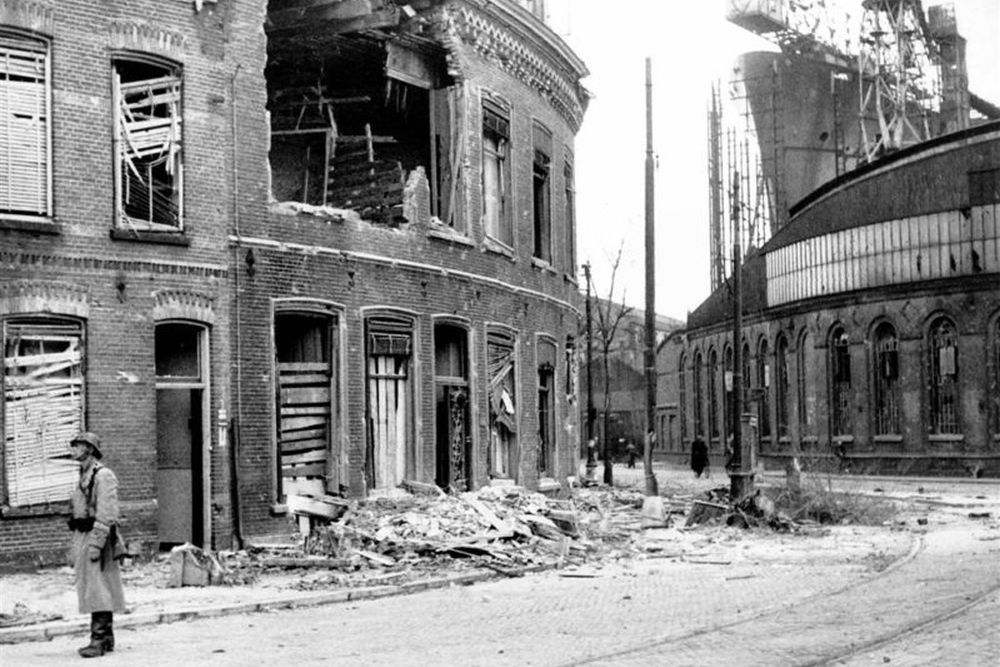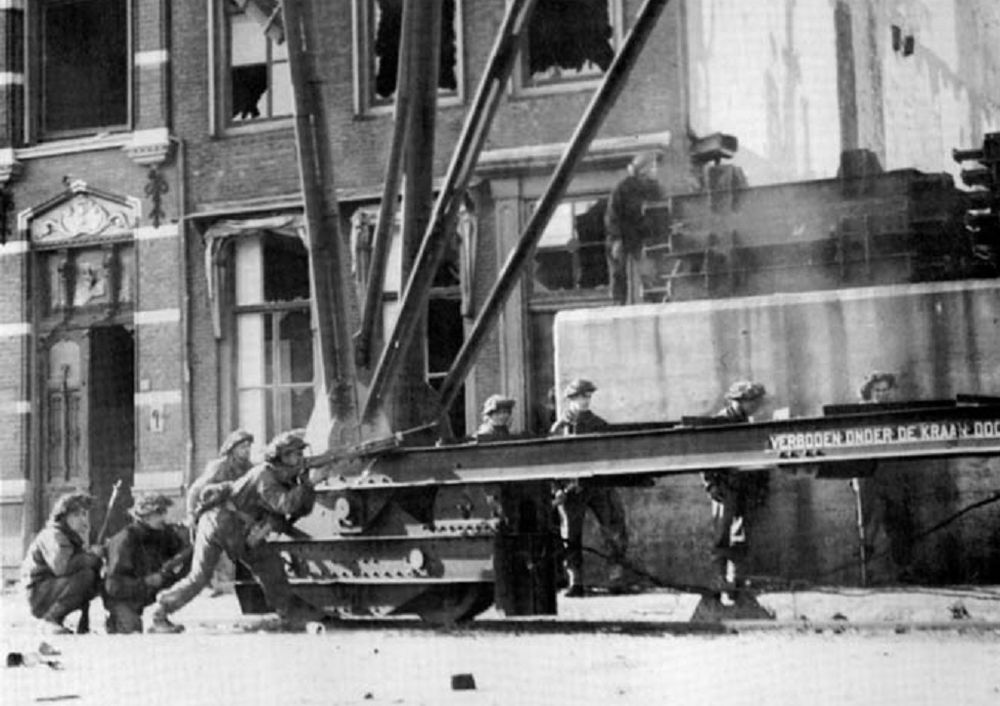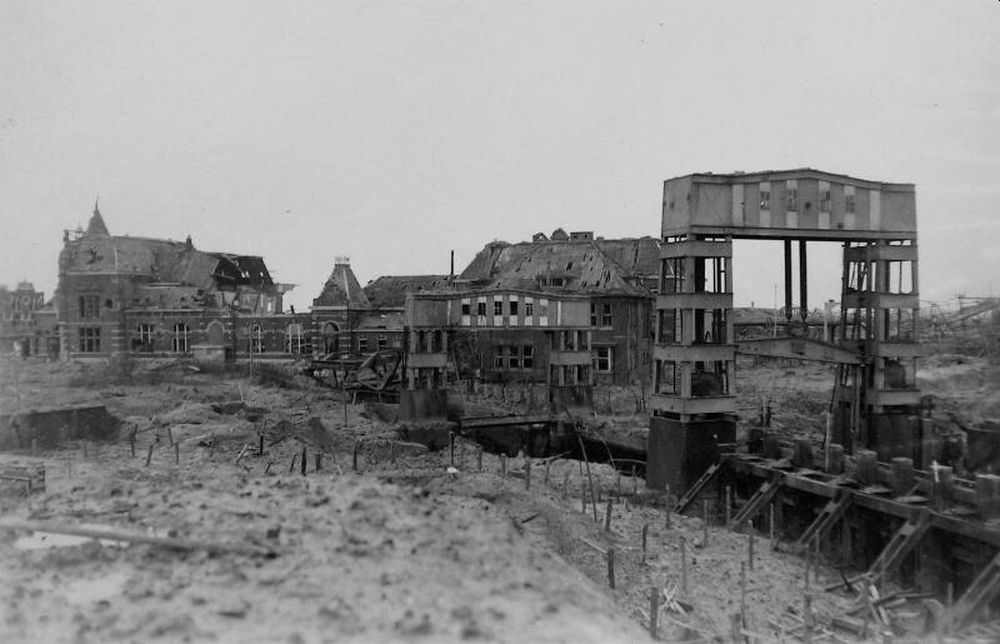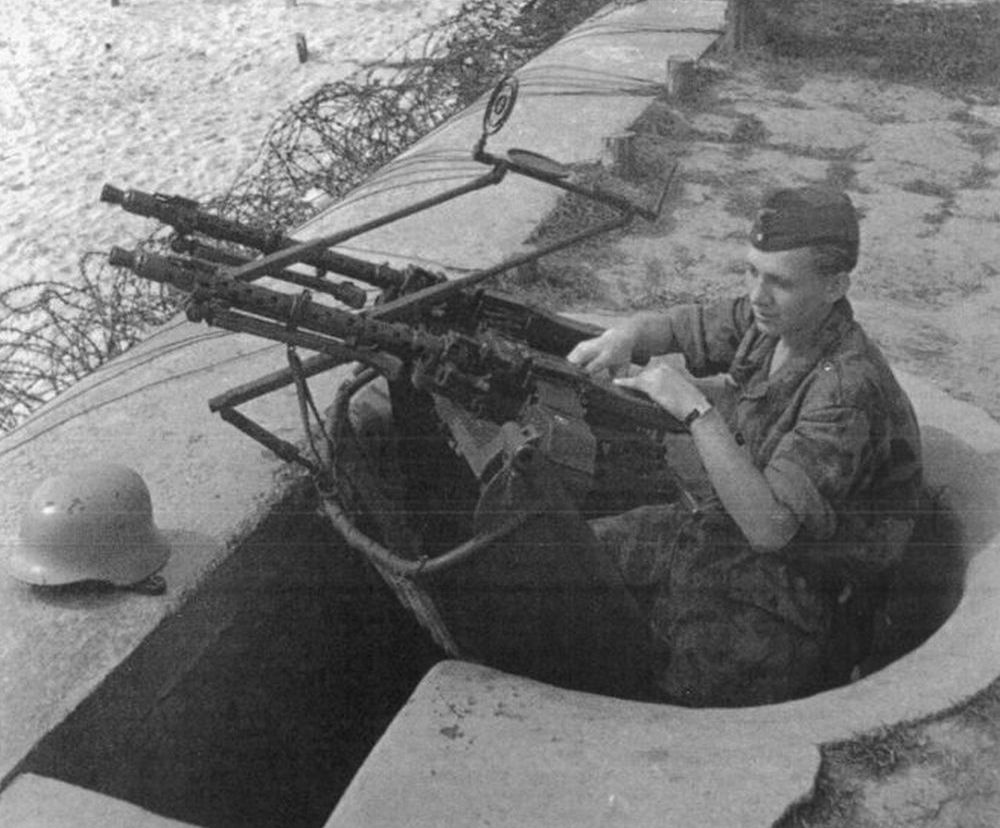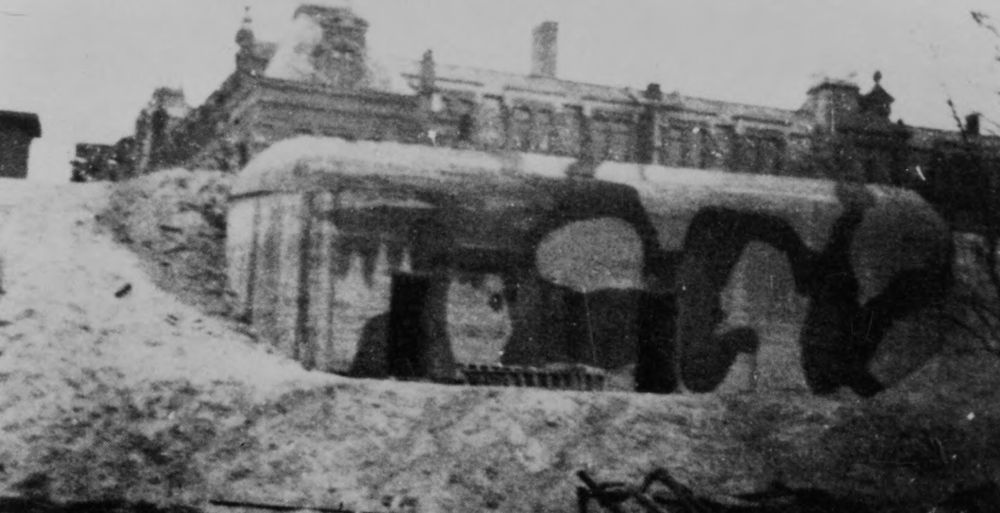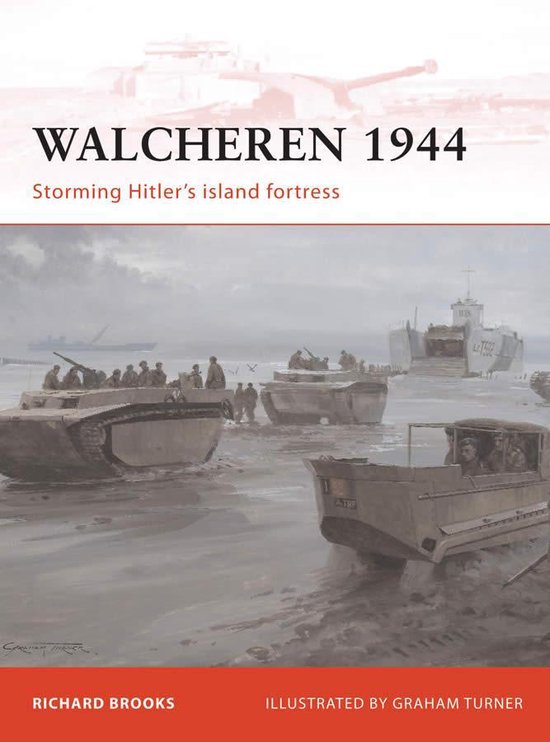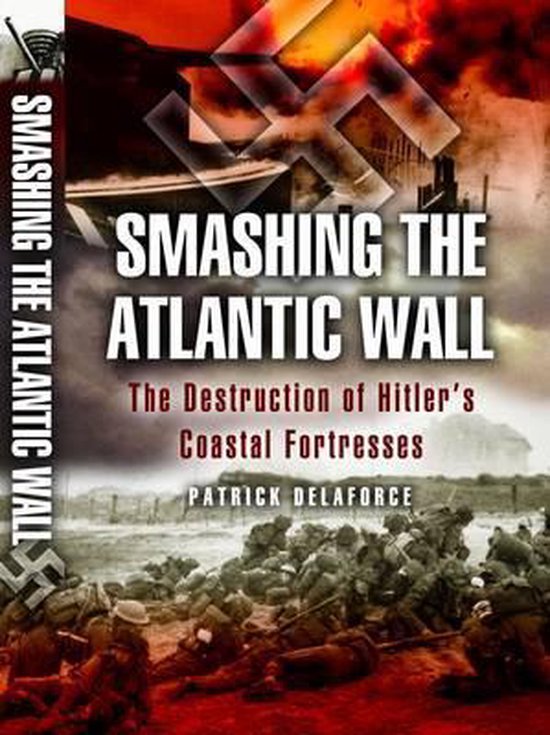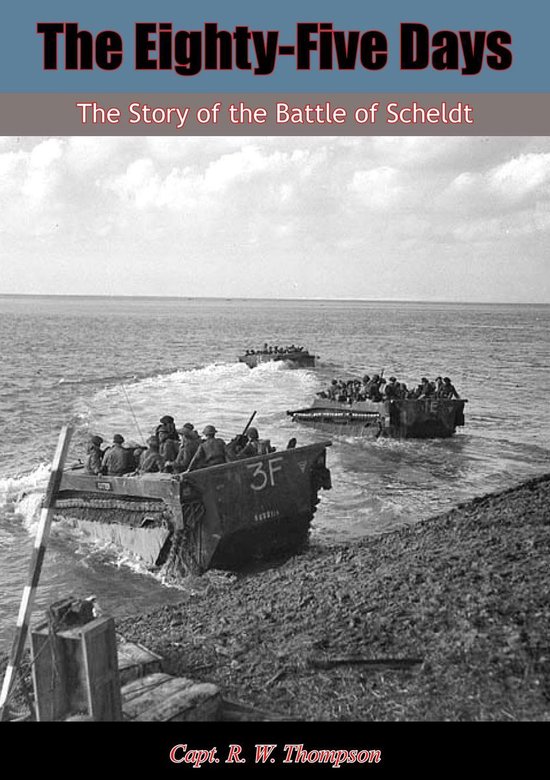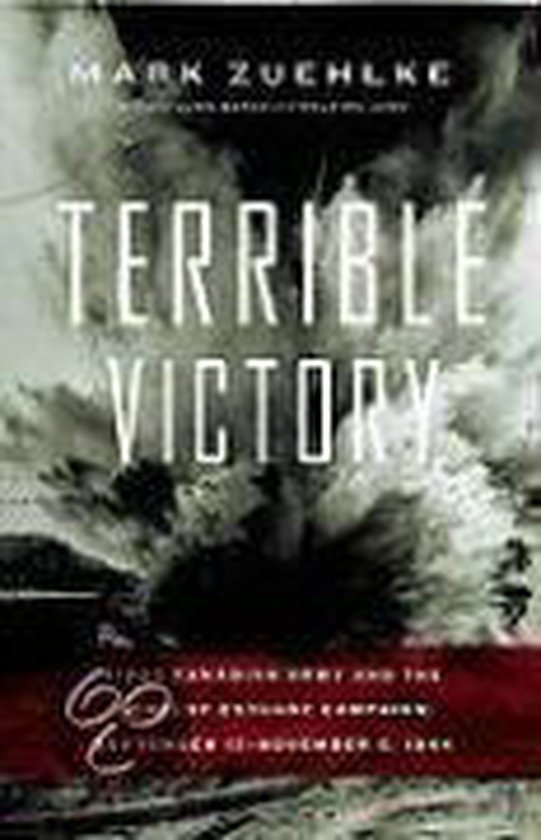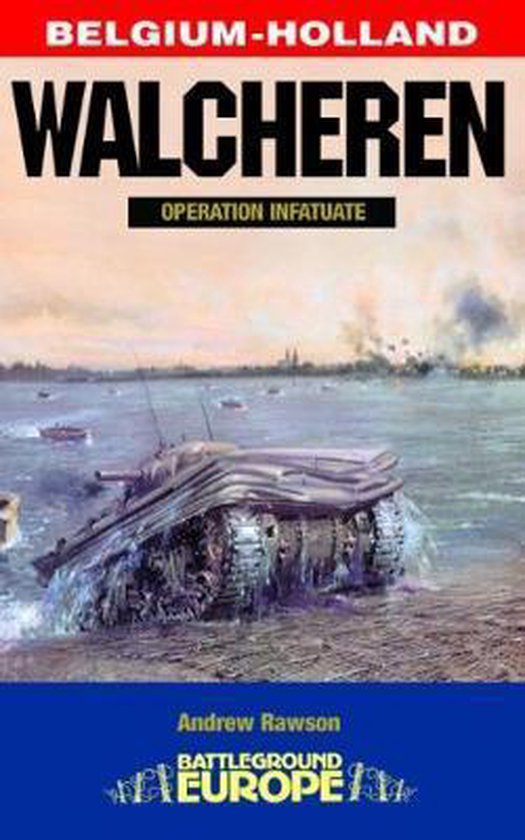Introduction
After No. 4 Commando had landed in the early morning of November 1, 1944 on Uncle Beach near the Oranjemolen in Flushing, a fierce battle of the port ensued against the local German troops. Once the 155th Infantry Brigade of the 52nd (Lowland) Infantry Division had taken over the advance, Flushing was liberated after Hotel Brittania had been captured.
Definitielijst
- Brigade
- Consisted mostly of two or more regiments. Could operate independently or as part of a division. Sometimes they were part of a corps instead of a division. In theory a brigade consisted of 5,000 to 7,000 men.
- Infantry
- Foot soldiers of a given army.
Situation on November 1, 1944
On November 1, 1944, No. 4 Commando had landed successfully in the Slijkhaven, also known as Ooster or Dokhaven. During that first day, they managed to capture a large part of the inner city from the German defense. Except for a few resistance nests, the entire area south of Coosje Buskenstraat, the De Schelde shipyard and the Binnenhaven had fallen into their hands[1].
During the day, the other units of the 155th Infantry Brigade had taken over their positions and from November 2 onwards, they prepared themselves to capture the rest of the city from the Germans. Here, they still faced an almost entirely complete Grenadier-Regiment 1019 which had entrenched itself in and around its HQ, Hotel Britannia. With a quadruple 20mm gun battery and various machinegun nests on the Boulevard at the end of Coosje Buskenstraat, the Germans denied the Allied passage to the area north of the line Coosje Buskenstraat, shipyard De Schelde and the Binnen and Buitenhaven[2][3]
Liberation of the rest of the city would be completed in three stages. On November 2, No. 4 Commando was to concentrate on the German fortification on the boulevard at the end of Coosje Buskenstraat, called Dover by the Allies. The 5th Battalion King's Own Scottish Borderers (5 KOSB) would simultaneously break out from the old inner city in the north to the new city, as this part was called and swing east in the direction of the Kanaal door Walcheren, cross it on November 4 and so capture the areas code named Haymarker, Strand and Piccadilly in the direction of the railway station. Following the actions on No. 4 Commando and 5 KOSB, 7th/9th Battalion Royal Scots was to launch an attack on Grand Hotel Britannia, the official name of the hotel. Completely unexpected, it would turn out that this was the strongly defended HQ of Verteidigungsbereich Vlissingen[4]
On the German side, Oberst Eugen Johannes Reinhardt had concentrated the remnants of his Grenadier-Regiment 1019 in and around a series of bunkers near and beneath the hotel. Dispersed in the north of the dry part of Flushing, various smaller elements of this units were located and to the east of the Kanaal door Walcheren, the Flushing harbor area, the 9. Batterie, Marine-Artillerie-Abteilung 202 was located; its men spread out over various defensive positions with Flak, coastal artillery and machinegun positions[5].
Definitielijst
- Abteilung
- Usually part of a Regiment and consisting of several companies. The smallest unit that could operate independently and maintain itself. In theory an Abteilung comprised 500-1,000 men.
- Brigade
- Consisted mostly of two or more regiments. Could operate independently or as part of a division. Sometimes they were part of a corps instead of a division. In theory a brigade consisted of 5,000 to 7,000 men.
- Flak
- Flieger-/Flugabwehrkanone. German anti-aircraft guns.
- Infantry
- Foot soldiers of a given army.
- Regiment
- Part of a division. A division divided into a number of regiments. In the army traditionally the name of the major organised unit of one type of weapon.
- resistance
- Resistance against the enemy. Often also with armed resources.
No. 4 Commando
No. 4 Commando launched its attack on Dover at 07:00 on November 2. Artillery from Breskens was deployed to shell the area around Dover. No. 5 Troop started its advance up Coosje Buskenstraat towards the boulevard. The first building that was captured, the Alhambra cinema was immediately turned into a gun emplacement from where the Germans were plastered with PIATs. Both sections of No. 5 Troop pushed through from house to house, even using gardens, roofs and blowing holes through walls to get from one house to the other[6].
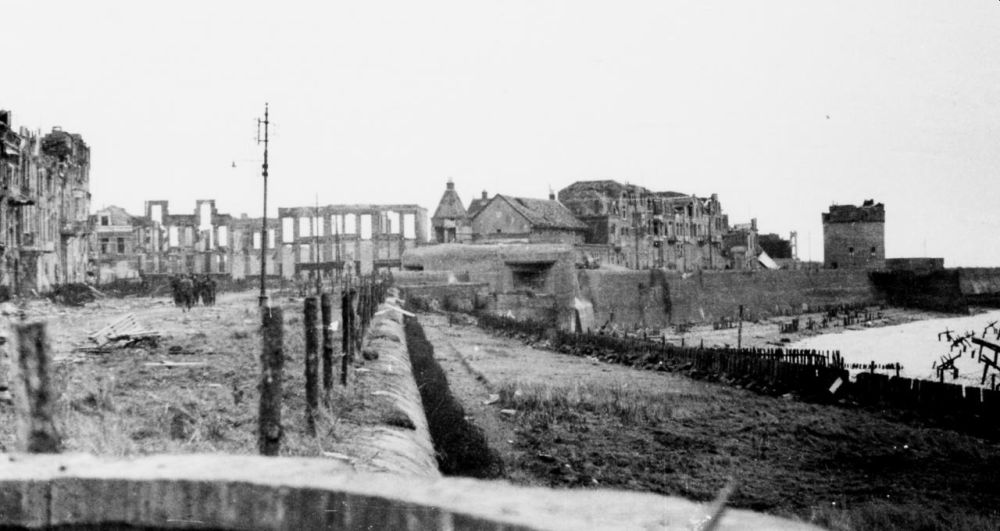
Dover with the bunker in the center, behind it the quadruple 20mm Flsk battery and Gevangentoren on the right. Source: Imperial War Museum
Around noon, German resistance around Dover had not been knocked down yet so the commandoes pulled back slightly to give Hawker Typhoon fighter bombers the opportunity to bomb German positions on and around Dover[7].
The French commandoes of No. 5 Troop eventually reached the boulevard and the bunker with the Flak battery at 16:30[8]. They were about to blow up the armored doors with PIAT shells when a white flag was raised and three German officers and 54 ranks surrendered.
Definitielijst
- Flak
- Flieger-/Flugabwehrkanone. German anti-aircraft guns.
- PIAT
- Projector Infantry Anti-Tank. British anti-tank weapon, used by infantry troops. It has the shape of a rifle and is based on the rifle principle. A PIAT can be reloaded.
- resistance
- Resistance against the enemy. Often also with armed resources.
5th Batt King's Own Scottish Borderers
This battalion, commanded by Lieutenant-colonel William F.R. Turner had landed in Flushing on November 1 at 17:00 and had settled down near the Arsenaal. That night, A Batt, O Group received its marching orders for the next day. A and C Company were ordered to advance through the positions of 4th KOSB by way of Betje Wolfplein and enter the areas code named Grouse and Cod[9].
At 05:00 they started their advance with A Company in the lead followed by C Coy; the latter was soon subjected to German mortar fire which caused many casualties including its commander. A fortification in the quay wall of the Spuikom turned out to be the source of this fire. One of the howitzers of 452nd Mountain Battery was called upon to help solve this problem. As its indirect fire was hardly effective, the entire gum was dismantled and taken to the sleeping room of a house with a view on the bunker. It was reassembled in 20 minutes and after eight rounds, the Germans left the bunker and retreated in the direction of hotel Britannia[10].
Around noon, 5 KOSB had achieved its goal, enabling B and D Company to strike towards the Kanaal door Walcheren past the shipyard and the Binnnenhaven. The area of the shipyard turned out to be an obstacle in its own right though. In the entire harbor area, the Germans had erected fortifications and where the Kriegsmarine personnel had been driven from their positions, they fought like infantry. Snipers were firing from the cranes and could only be driven off with difficulty. Here again, the guns of the 452nd Mountain Battery were deployed to drive the snipers out. Towards nightfall, these two companies had reached their objectives as well. B Company had taken up positions near the Keersluisbrug across the canal and D Coy was on their right flank in the shipyard[11].
On November 3, 5 KOSB had their work cut out for them, clearing the various smaller German resistance nests in the eastern part of Flushing. Supported by artillery and Hawker Typhoon fighter bombers, the German fortifications were cleared one by one until sufficient ground was gained to attempt a crossing of the Kanaal door Walcheren. In the early morning of November 4, B and D Company opened the attack by crossing the canal. B Coy secured the left flank to the north, capturing the railway shunting yard in the process and a German fortification in the vicinity. With this, the northern flank was secured. D Coy penetrated the area of the Binnenhaven, capturing the positions code named Haymarket and Strand. Subsequently, they advanced towards the railway station. Towards 05:30, all units had captured their objectives. C Coy subsequently moved through the positions of B and D Coy in order to take on the fortifications around the Buitenhaven. Resistance here was much stronger, partly due to the presence of strong German coastal batteries. Later that day, A Company took over the attack from C Coy and entered the eastern port area of the Buitenhaven. Meanwhile, B Coy advanced along the railway line northwards in order to find out which German fortifications were located in the direction of Oost Souburg. The surrounding area was flooded but the railway line and the dykes of the canal rose above the water[12].
On November 4, 5 KOSB had reached all its goals. The unit suffered nine deaths and fifty-three injured. 4 KOSB, which had mainly been busy clearing various resistance points in Flushing after its performance on November 1, suffered 10 deaths and 65 injured. The number of German victims is unknown but 5 KOSB counted over 400 prisoners of war[13][14]
Definitielijst
- infantry
- Foot soldiers of a given army.
- Kriegsmarine
- Germa navy. Part of the Wehrmacht next to Heer and Luftwaffe.
- mortar
- Canon that is able to fire its grenades, in a very curved trajectory at short range.
- resistance
- Resistance against the enemy. Often also with armed resources.
7th/9th Battalion, Royal Scots
This battalion had arrived in Flushing on November 2 and was deployed to prevent German infiltrations from the locks near the railway station via the Eiland called Falmouth by the Allies. In the night of November 2 to 3 they were redeployed on the front line in Flushing in order to capture the area around Grand Hotel Britannia, the official name of the hotel[15][16].
The Germans had turned the hotel into a true fortress. It could be approached via the boulevard or by wading through the water behind said boulevard. The area surrounding the hotel had been transformed into a fort with trenches, fortifications, bunkers, machinegun posts and gun emplacements. The hotel itself was flanked by emplacements camouflaged as residential houses. On the roof of the hotel stood a quadruple 20mm Flak gun. The hotel was protected at the back by the high embankment of the boulevard itself and several bunkers had been dug into it. Beneath the hotel there were command bunkers, the entries of which were protected by gun emplacements and machinegun nests[17].
At 21:30 on November 2, Lieutenant-colonel Michael E. Melvill, commander of the Royal Scots, received the order to capture the hotel the next day. En route to the hotel, little existence was expected and resistance within the hotel was considered weak. It was decided to approach the complex from the north with D Company, commanded by Major Chater on the right flank. B Coy, commanded by Major Rose was to take the left flank and C Coy, commanded by Captain Thomson would lend supporting fire. A Carrier Platoon equipped with PIATs and Bren machineguns was to lend support as well. This plan meant that advance and attack would have to be carried out wading through three feet of water. In order to deliver ammunition a number of attack vessels and Weasels would be made available. The assault was to be launched from Vrijdomweg in the park behind Boulevard Evertsen on which the hotel stood. This position could only be reached from Bexhill (Betje Wolfplein) by wading through three feet of water for about a mile. Taking the Badhuisstraat, the troops would turn onto the Koudekerkseweg near the water tower, past the hospital to Vrijdomweg[18].
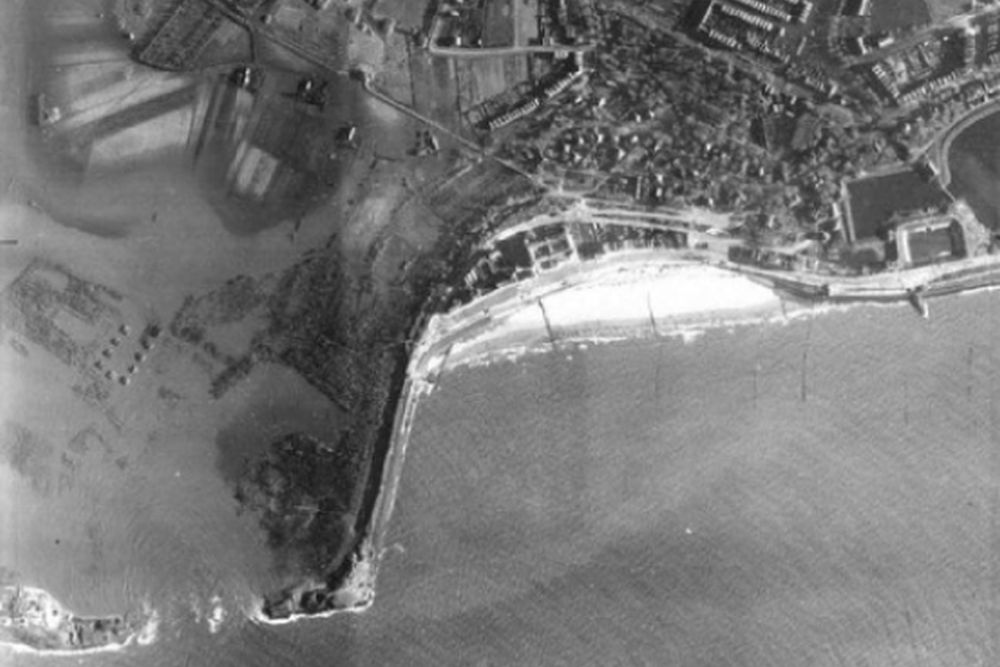
Grand Hotel Britannia in the center, on the left the breach in the Nolledijk and the flooded land. Source: Royal Air Force photo
At 01:45, an artillery bombardment was unleashed on the target area and the Royal Scots went on their way down Badhuisstraat. Carrier Platoon took the lead, followed by B and D Coy, Tactical Headquarters and C Coy. The column was soon subjected to German fire and about half of Carrier Platoon was eliminated. Next, they came under fire from a machinegun in the water tower. Slowly but surely, they managed to overcome both making good use of artillery support. On reaching Vrijdomweg, the water turned out to be much higher than expected and the assault line was shifted to the shallower intersection with Vredehoflaan closer to the hotel. B Coy would now attack on the right flank with D Coy in support on the left. C Coy was to lend fire support on the left flank and Carrier Platoon on the right[19].
At 04:15, No. 16 Platoon of D Company was the first to charge a bunker on Burgemeester van Woelderenlaan at the foot of the dyke. During this action, 30 German soldiers were made prisoner. B and D Coy subsequently approached the dyke together and came under direct German defensive fire. Climbing the dyke fast, Nos 17 and 18 Platoon of D Coy, with supporting fire from B Coy and a platoon of C Coy, managed to enter the ground floor of the hotel, sealing off the entry to the cellar. The rest of D Company followed at 06:00 and penetrated the upper floor. Inside the hotel, fire fights erupted between attackers and defenders. The commanders outside had no way whatsoever to monitor the developments inside as meanwhile all entries were subjected to German fire. B Company was completely nailed down by shells and machinegun fire. Lieutenant-colonel Melvill and his signaler were hit by a sniper from the Witte Huis near the hotel[20][21].
At 06:30, No. 13 Platoon of Coy managed to get through to the hotel and took it upon itself to silence the 20mm gun on the roof. This gun had been set up in such a way as to cover various entrances to the hotel. Climbing up the rain pipe, Lieutenant Beveridge managed to reach the roof and forced the gunners to flee. Once the gun had been disabled, B Coy advanced further and captured the Witte Huis close to the hotel. Due to the fighting, this had caught fire and the three platoon commanders decided to have their men continue the battle via the trenches south of the hotel in the direction of the cellars beneath. On arrival, they discovered a gigantic subterranean command center where they encountered Oberst Reinhardt, commander of Grenadier-Regiment 1019 and many of his men. Under threat of his bunker being blown up, Reinhardt decided to give up the fight[22].

Hotel Britannia after the battle, on the right one of the camouflaged gun emplacements. Source: Gemeentearchief Vlissingen
Between 11:00 and 11:30, the battle petered out and the German prisoners were taken away. In and around the hotel, 50 dead German soldiers were found and the number of POWs stood at about 600. Reportedly, the Royal Scots mourned 20 dead, including 3 officers and over 50 injured. For his contribution to the battle around the hotel, Major Rose was awarded the Distinguished Service Cross[23].
Notes
- Zuehlke, 2008, p. 448
- Brooks, 2011, p. 34
- Zuehlke, 2008, p. 448
- Brooks, 2011, p. 59
- Brooks, 2011, p. 60-61
- Brooks, 2011, p. 62
- Brooks, 2011, p. 62
- Brooks, 2011, p. 62
- Brooks, 2011, p. 62
- Brooks, 2011, p. 63
- Brooks, 2011, p. 63-67
- Brooks, 2011, p. 67
- Brooks, 2011, p. 67
- Zuehlke, 2008, p. 448
- Brooks, 2011, p. 67
- Delaforce, 2005, p. 192-193
- Brooks, 2011, p. 67
- Brooks, 2011, p. 68
- Brooks, 2011, p. 68-69
- Brooks, 2011, p. 69
- Delaforce, 2005, p. 192-193
- Brooks, 2011, p. 69
- Brooks, 2011, p. 69
Definitielijst
- Flak
- Flieger-/Flugabwehrkanone. German anti-aircraft guns.
- Regiment
- Part of a division. A division divided into a number of regiments. In the army traditionally the name of the major organised unit of one type of weapon.
- resistance
- Resistance against the enemy. Often also with armed resources.
- sniper
- Military sniper who can eliminate individual targets at long distances (up to about 800 meters).
Information
- Article by:
- Wilco Vermeer
- Translated by:
- Arnold Palthe
- Published on:
- 16-07-2023
- Last edit on:
- 30-09-2024
- Feedback?
- Send it!
Related books
Sources
- BROOKS, R., Walcheren 1944, Osprey Publishing Ltd., Botley, Great Britain, 2011.
- DELAFORCE, P., Smashing the Atlantic Wall, Casemate Publishers, 2005.
- RAWSON, A., Walcheren, Pen and Sword, Havertown, 2020.
- THOMAS G.A., Attack on the Scheldt, Pen & Sword Military, Barnsley, 2017.
- THOMPSON, R.W., The Eighty-Five Days, Pickle Partners Publishing, 2017.
- ZUEHLKE, M., Terrible Victory, Douglas & McIntyre Publishers Inc., Vancouver, Canada, 2008.
